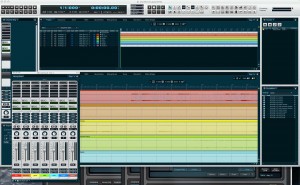The composer’s process – the evolution of a soundtrack
 Back in September I started work on scoring a new video project featuring performance artist Laura Milkins and a variety of time lapse landscape footage.
Back in September I started work on scoring a new video project featuring performance artist Laura Milkins and a variety of time lapse landscape footage.
Tentatively titled “Poem From Memory,” the piece depicts Milkins walking through a variety of surreal terrains.
The landscapes have been sped up to 5000 percent, while the footage of Milkins has been slowed down to 33 percent of its original speed.
The accelerated footage of the landscape reveals the building and flow of various layers of clouds, sometimes in different directions at different altitudes, as well as the shadows of clouds floating over the ground below.
Likewise the slowed down version of Milkins’ walk and stylized posturing accentuates the surreal juxtaposition as the two are layered and blended.
There is a magical quality to the bringing together of these images. And that, along with the surreal flow, is what I hope to achieve in the musical score.
Using MOTU’s Digital Performer I was able to import the video so that I could watch it full screen as I improvised. The first instrument I initially chose was Soniccouture’s EP73 Deconstructed – a heavily sampled library of Electric Piano sounds, formatted for Native Instruments’ Kontakt sampler.
I used the multi version of the instrument and assigned all of its layers to the same MIDI source so that I could play them all at once – sounds produced by using the keyboard, plucking and striking the electric piano’s metal tynes, along with a pad constructed using the source electric piano. This was the magical basic sound I was looking for, and with the modulation wheel programmed to pluck the tines in an arpeggiated fashion, it was rigged for variety and sparkle.
Harmonically and in terms of chord progression I wanted some ambiguity and unlikely motion, and yet also to tie the improvisation together organically.
There is also an FX layer to this electric piano sample library which features unusual sounds one can get by torturing this poor electric piano in cruel and unusual ways. I used it as well, assigning that sound set to a different MIDI channel so I could add it separately and locate it elsewhere in the mix. I recorded this track next.
This was followed by tracks for MOTU Mach V’s acoustic guitar sample instrument, Native Instruments’ Motown cellos and 8Dio’s solo violin. A touch of organ pedal was added later as well.
Naturally mistakes were made, and so following the recording of the tracks there was a considerable period of fixing MIDI – comping different riffs, moving notes around, adjusting their note velocities and correcting improper pitches. The solo violin parts changed the most to accentuate the evolving beauty and unlikely juxtaposition of the visual elements.
Throughout the entire score, a sense of surrealism, ambiguity and liquid flow was sought.
The next step, which was recently undertaken, was to “freeze” the MIDI tracks, or export them as audio.
Tonight I created a new project document that brings together all of the frozen tracks from the original soundtrack, synced to a revised version of the video.
Once the tracks were imported I used individual instances of Izotope’s Alloy software to heighten the sound of each track. A bit of reverb was added to the cellos at this stage as well.
Next up is a preliminary mix of the elements, or rather several passes at it, using Digital Performer’s automation properties.
I will likely also experiment with a variety of sound filtering and altering software options as well.
The final piece should be soft and surreal, evolutionary and malleable in form.
Updates and sound examples to follow.
– Daniel Buckley, 10/27/12
